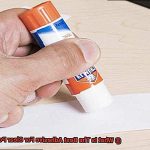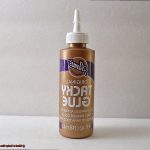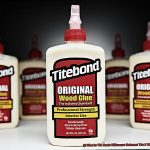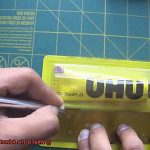Crystal glass – a material that exudes opulence and grace, is used to create some of the most stunning homewares, decorative items, and ornamental pieces. From dainty vases to intricately crafted figurines, crystal glass is undeniably captivating. However, owning a piece of crystal glass can also mean facing challenges such as repairing a chipped or broken item. But fear not. The solution lies in finding the right adhesive – one that will repair your precious piece without compromising its beauty.
So what is the best adhesive for crystal glass? That’s precisely what we’re here to explore in this blog post. We’ll delve deep into the world of crystal glass adhesives and explore ideal options for repairing your prized possessions. We’ll take a closer look at factors such as drying time, level of transparency, bond strength, and ease of use. Furthermore, we’ll discuss why using the wrong adhesive could prove disastrous and how it could impact the aesthetic value of your crystal glass item.
But wait – there’s more. We’ll also provide you with tips on how to apply adhesive seamlessly to your crystal glass piece so that it looks as good as new. Whether you’re an avid collector or simply own a family heirloom, having knowledge about which adhesive works best for your crystal glass piece is crucial.
So let’s get started on our journey to discover the perfect adhesive for all your crystal glass repair needs.

Types of Adhesives for Crystal Glass
Contents
- 1 Types of Adhesives for Crystal Glass
- 2 Epoxies
- 3 Cyanoacrylates
- 4 Polyurethanes
- 5 Silicones
- 6 Benefits of Using Epoxies for Crystal Glass Bonding
- 7 Benefits of Using Cyanoacrylate Glues for Crystal Glass Bonding
- 8 Benefits of Using Polyurethane Adhesives for Crystal Glass Bonding
- 9 Benefits of Using Silicone Adhesives for Crystal Glass Bonding
- 10 Factors to Consider When Choosing an Adhesive for Crystal Glass
- 11 Tips and Tricks For Applying Adhesives to Crystal Glass Surfaces
- 12 Common Mistakes to Avoid When Applying Adhesives to Crystal Glass Surfaces
- 13 Conclusion
Crystal glass is a delicate material that requires a sturdy adhesive to ensure a long-lasting and secure bond. Fortunately, there are several types of adhesives available in the market, each with its unique properties and advantages. Let’s delve deeper into the different types of adhesives for crystal glass:
Epoxy Adhesives
Epoxy adhesives are a popular choice for bonding crystal glass due to their strength and durability. They can also be tinted to match the color of the glass, making them ideal for repairing cracks or chips in crystal items. However, epoxy can be challenging to work with and requires precise mixing ratios.
Epoxy is a two-part adhesive that consists of resin and hardener. This type of adhesive is known for its strong bonding ability, durability, and resistance to water and chemicals. It is ideal for bonding crystal glass surfaces where maximum strength is required.
UV-Cured Adhesives
UV-cured adhesives are another suitable option for bonding crystal glass. These adhesives use ultraviolet light to cure and harden the adhesive. They are often used in industrial applications but can also be used for repairing crystal glass items. They are easy to use, fast-curing, and provide a strong bond.
UV-cured adhesives are excellent for bonding large areas of crystal glass surfaces and can create a bond that does not yellow with age.
Cyanoacrylate Adhesives
Cyanoacrylate adhesives, commonly known as super glue, are a popular choice for bonding crystal glass because they dry quickly and provide a strong bond. However, they can be brittle and may not be suitable for high-stress applications.
This adhesive is a fast-drying, clear liquid that forms an instant bond between surfaces. Super glue is ideal for small repairs and bonding delicate pieces of crystal glass.

Silicone Adhesives
Silicone adhesives are a flexible and durable option for bonding crystal glass that may experience stress or vibration. They are also resistant to water and heat. However, silicone adhesives can take longer to cure than other types of adhesives.
Silicone adhesives are ideal for outdoor applications or bonding pieces subject to movement or stress. They offer excellent resistance to heat and cold temperatures, making them a great choice for outdoor projects.
Polyurethane Adhesives
Polyurethane adhesives are strong and flexible, making them a good choice for bonding crystal glass that may experience stress or movement. They are also resistant to water and heat. However, like silicone adhesives, they can take longer to cure than other types of adhesives.
When choosing an adhesive for crystal glass, it’s important to consider the specific characteristics of each type and how they will meet your needs. It’s also crucial to follow the manufacturer’s instructions carefully to ensure a strong and lasting bond.
Epoxies
The impressive strength and durability of epoxies make them an ideal choice for projects that require a long-lasting bond.
Epoxies are unique in their ability to fill gaps between surfaces, making them perfect for bonding crystal glass even if the surfaces aren’t perfectly flat. This filling capability ensures a strong and secure bond.
When working with epoxies for bonding crystal glass, it’s essential to choose a product that is specifically designed for this purpose. Not all epoxies are suitable for use with glass, and some may require special preparation or curing times to ensure a successful bond.
Proper preparation is the key to success when using epoxies. It’s vital to ensure that both surfaces are clean and dry before applying the adhesive and allowing sufficient curing time before handling or using the bonded items. With careful adherence to the manufacturer’s instructions, you’re guaranteed to get excellent results.
The strength and durability of epoxies make them stand out from other types of adhesives. They can withstand exposure to water, heat, and other harsh conditions without breaking down or losing their adhesive properties. To ensure the best possible bond without damaging or discoloring the glass, it’s crucial to choose an epoxy that is specifically formulated for use with glass.
Cyanoacrylates
If you’re looking for a reliable adhesive to bond your crystal glassware, cyanoacrylates, aka “super glue,” are a top choice. These adhesives are known for their ability to dry quickly and create a strong bond, thanks to their reaction with moisture in the air.
One of the great benefits of using cyanoacrylates is their versatility- they can bond a wide range of materials including glass, metal, and plastic. This adhesive also has a clear finish, making it perfect for transparent materials like crystal glass. However, it’s worth noting that cyanoacrylates can be brittle and may not hold up well under stress or impact.
When working with cyanoacrylates on crystal glassware, it’s crucial to follow the manufacturer’s instructions carefully. Applying the adhesive in a thin layer and allowing it to fully dry before handling the bonded object is essential. Overuse of the adhesive may cause the bond to become brittle and break over time.
While cyanoacrylates can be an effective option for bonding crystal glassware, they might not be suitable for certain types of crystal glass that are sensitive to solvents or chemicals. It’s important to consider the specific type of glass and application before choosing an adhesive.
Polyurethanes
Polyurethane adhesives are here to save the day.
Polyurethanes are highly popular adhesives known for their incredible strength and durability, making them the go-to choice for bonding crystal glass. Their resistance to water and temperature changes also makes them ideal for use in environments where the adhesive may be exposed to moisture or extreme temperatures.
One major advantage of polyurethane adhesives is their ability to fill gaps and provide a rock-solid bond. This is particularly useful when bonding irregularly shaped pieces of glass or when there are slight variations in the surface of the glass.
Available in both one-part and two-part formulas, polyurethane adhesives offer flexibility in terms of choosing the product that best suits your needs.

However, it is crucial to note that not all polyurethane adhesives are created equal. Choosing a product specifically designed for bonding crystal glass is essential, as some polyurethanes may not provide a strong enough bond or may even cause damage to the glass surface.
To ensure a successful bond, it’s important to follow the manufacturer’s instructions carefully. This includes preparing the surface of the glass correctly before applying the adhesive and allowing sufficient time for it to dry and cure.
Silicones
When it comes to bonding delicate crystal glass, finding an adhesive that can handle its fragility can be a daunting task. Luckily, silicone adhesives are here to save the day. As an expert in this field, I can confidently say that silicones offer a wide range of benefits when it comes to bonding crystal glass.
First and foremost, silicones are remarkably versatile and can withstand extreme temperatures and weather conditions. This makes them the perfect adhesive option for outdoor applications or in areas that experience high levels of humidity or moisture. With silicones, you won’t have to worry about your crystal glass falling apart due to changes in temperature or weather conditions.
In addition to their versatility, silicone adhesives offer a high level of flexibility. They can bend and stretch without cracking or breaking, which is crucial when dealing with delicate materials like crystal glass. With a reliable and flexible bond, you can rest assured that your glass pieces will stay securely in place.
When selecting a silicone adhesive for bonding crystal glass, be sure to choose a product that is specifically designed for this type of material. Look for a clear silicone adhesive that won’t discolor or yellow over time, and make sure it is rated for high strength and durability.
Benefits of Using Epoxies for Crystal Glass Bonding
Look no further than epoxies, the go-to choice for bonding crystal glass. But what makes epoxies so special?
Firstly, epoxies possess exceptional bonding capabilities, ensuring that your crystal glass pieces remain firmly in place even under high stress and pressure. This strong bond is essential for delicate crystal glassware that is often subjected to everyday wear and tear.
Beyond their strength, epoxies are also incredibly versatile. With various formulations available, they are perfect for bonding clear or transparent materials like crystal glass without leaving any visible residue. This feature ensures that your crystal glassware looks as good as new after every repair.
Another key advantage of using epoxies is their long working time. This extended period provides users with ample time to position and adjust the pieces before the adhesive sets fully. This attribute is particularly important when working with delicate crystal glass pieces that require precision and accuracy during the bonding process.
Epoxies are also waterproof and heat-resistant, making them ideal for use in areas with high humidity or temperature fluctuations. This feature guarantees that the bond between the crystal glass pieces remains strong and intact even in adverse conditions.
Overall, epoxies offer numerous benefits when it comes to bonding crystal glass. Their strong bonding capabilities, versatility, long working time, and resistance to water and heat make them an excellent choice for anyone looking to bond crystal glass pieces effectively.
Benefits of Using Cyanoacrylate Glues for Crystal Glass Bonding
Look no further than cyanoacrylate glues, also known as super glues, for all your crystal glass bonding needs. As an expert in the field, I can attest to the numerous benefits of using cyanoacrylate glues for crystal glass bonding.
One of the most significant advantages of cyanoacrylate glues for crystal glass bonding is their ability to form a tight and durable bond within seconds of application. In situations where time is of the essence, such as repairing broken crystal glassware, this feature is particularly beneficial.
Another benefit of using cyanoacrylate glue is their ability to dry clear and leave no residue or marks. This is crucial when dealing with delicate and valuable crystal glass objects, as it ensures that the clarity and beauty of the glass are not compromised in any way.
Cyanoacrylate glues are renowned for their excellent adhesive strength, making them an ideal option for repairing chipped or cracked crystal glassware. They can bond crystal glass objects together securely and prevent them from coming apart easily, giving you peace of mind knowing that your items will remain intact.
Moreover, these glues come with precision applicator tips or brushes that allow greater control over the amount of glue used and where it is applied. This minimizes the risk of accidentally applying too much glue or getting it on areas where it should not be. In this way, you can ensure that your delicate crystal glass objects remain intact while performing repairs.
To sum up, cyanoacrylate glues are an excellent option for bonding crystal glass due to their fast-acting properties, clear drying capabilities, strong adhesive strength, and easy application. However, it is worth noting that they may not be suitable for all types of crystal glass. Always read the manufacturer’s instructions carefully before use to ensure that you are using the appropriate type of glue for your specific needs.
Benefits of Using Polyurethane Adhesives for Crystal Glass Bonding
Polyurethane adhesives offer exceptional strength and durability, making them a top choice for bonding crystal glass objects.

One of the main benefits of using polyurethane adhesives is their resistance to water and moisture. These adhesives are waterproof and can withstand exposure to water without losing their adhesive properties. This makes them ideal for use in applications where the glass will be exposed to water or other liquids, like in aquariums or other water features.
In addition, polyurethane adhesives can withstand extreme temperatures ranging from -40°C to 100°C, making them suitable for use in both hot and cold environments. This feature is particularly important for industrial settings or outdoor environments, where temperature fluctuations are common.
Polyurethane adhesives are also incredibly versatile. They can bond crystal glass to a wide range of materials, including metal, plastic, wood, and more. This versatility makes them an excellent choice for a variety of applications and ensures that you can use them in almost any project.
Finally, polyurethane adhesives are easy to use and apply. They can be applied using a brush, roller, or spray, and they cure quickly. This means that you can handle and use your bonded materials soon after application.
Benefits of Using Silicone Adhesives for Crystal Glass Bonding
Look no further than silicone adhesives. As an expert in crystal glass bonding, I can confidently say that silicone adhesives offer numerous benefits that make them the ideal choice for this task.
Firstly, silicone adhesives have excellent resistance to moisture and temperature changes. Whether it’s regular use or cleaning, crystal glass items often encounter moisture, making them susceptible to damage. However, with silicone adhesives, your crystal glass items can remain secure and intact even in humid environments or extreme temperatures.
Secondly, the flexibility of silicone adhesives makes them perfect for bonding materials that may expand or contract over time. This feature is particularly important for crystal glass items exposed to varying temperatures and environments. The flexibility of these adhesives helps absorb any shock or vibration that may occur during handling or transport, further protecting the crystal glass from damage.
Additionally, silicone adhesives dry clear, which makes them an excellent choice for bonding delicate crystal glass items without leaving any visible residue. This transparency ensures that the adhesive will not alter the appearance of the crystal glass item in any way, enabling its beauty to shine through.
Finally, silicone adhesives are known for their durability and longevity. These adhesives can withstand exposure to UV light, which can cause other adhesives to break down over time. As a result, silicone adhesives are a reliable choice for bonding crystal glass items that will be exposed to sunlight or other light sources.

Factors to Consider When Choosing an Adhesive for Crystal Glass
With several adhesives available in the market, it’s crucial to consider several factors to make an informed decision.
Firstly, it’s essential to determine the type of glass you are working with since different glass types require different adhesives. Lead crystal glass, for example, is more delicate and requires a gentler adhesive than regular glass. Using the wrong adhesive can damage the glass and cause it to crack or break.
The strength of the adhesive is another crucial factor to consider. Crystal glass objects can be heavy and require an adhesive that can withstand weight without breaking or coming apart. Additionally, if the object will be subject to stress or pressure, a strong adhesive is necessary to keep it securely intact.
The transparency of the adhesive is also critical in maintaining the beauty of your crystal glass object. Since crystal glass is transparent, it’s crucial to choose an adhesive that doesn’t create a hazy appearance on the glass. Some adhesives dry clear, while others have a yellowish or cloudy appearance.
Flexibility is another vital factor to consider when choosing an adhesive for crystal glass. The object may be subject to temperature changes or movement, and a flexible adhesive will allow the glass to expand and contract without cracking or coming apart.
Finally, it’s essential to take drying time into account when selecting an adhesive for your project. Some adhesives require longer drying times than others, which can impact your project timeline. Additionally, some adhesives may require special tools or equipment for application, so be sure to factor that into your decision-making process as well.
Tips and Tricks For Applying Adhesives to Crystal Glass Surfaces
When it comes to applying adhesives to crystal glass surfaces, there are several tips and tricks to keep in mind to ensure a successful bond. First, it is crucial to choose the right adhesive for the job.
The adhesive should be clear and transparent, and it should not yellow or discolor over time. Popular options include cyanoacrylate glue, epoxy, and silicone adhesive, but it is important to select the best one for your specific project and materials.
Next, before applying any adhesive, it is important to clean the surface of the crystal glass thoroughly. Any dirt, dust, or oils can interfere with the bond and cause the adhesive to fail. Using a mild soap and water solution followed by a thorough drying with a lint-free cloth is recommended.
When applying the adhesive, use a small amount and apply it precisely where it is needed. Too much adhesive can seep out around the edges of the glass and create unsightly bumps or drips. It is also important to follow the manufacturer’s instructions carefully, which may include mixing two components together or allowing the adhesive to cure for a certain amount of time before handling.
Once the adhesive is applied, allow ample time for it to cure before handling or moving the glass. This can range from a few hours to several days depending on the specific adhesive used. Rushing the curing process can weaken the bond and cause the adhesive to fail over time.
Finally, handle the glass with care after it has been glued. Crystal glass can be fragile and prone to cracking or chipping if dropped or bumped. Avoid putting unnecessary stress on the glued area and handle with care.
Common Mistakes to Avoid When Applying Adhesives to Crystal Glass Surfaces
When it comes to working with crystal glass surfaces and adhesives, it’s important to avoid common mistakes that can lead to ineffective bonding or damage to the glass itself. Here are some tips to help you achieve a strong and reliable bond:
Don’t over-apply adhesive – less is more in this case. Using too much adhesive can weaken the bond and create a mess that could be difficult to clean up. Apply the adhesive precisely where needed.
Clean your crystal glass surface thoroughly before applying any adhesive. Dirt, oils, or residue can interfere with the bonding process and weaken the strength of the adhesive. Use a gentle cleanser and allow ample time for the surface to dry completely.
Choose an adhesive that is specifically designed for use on glass surfaces and follow the manufacturer’s instructions for application and drying time. Not all adhesives are created equal, and using the wrong type can lead to disaster.
Allow ample time for the adhesive to fully cure before handling or putting stress on the bonded area. Rushing the drying process can compromise the bond and lead to problems down the line.
5fRUOt9KFkI” >
Conclusion
When it comes to finding the best adhesive for crystal glass, there are a few options that stand out. From epoxy to cyanoacrylate, each has its own unique strengths and weaknesses. Ultimately, the choice depends on the specific needs of your project.
Epoxy is a popular choice due to its strong bonding capabilities and ability to fill gaps. However, it can take longer to dry and may not be suitable for smaller pieces.
Cyanoacrylate, also known as super glue, is a fast-drying option that works well for smaller pieces or when time is of the essence. It’s important to note that it may not be as strong as epoxy and can sometimes leave a white residue.
No matter which adhesive you choose, it’s crucial to follow the manufacturer’s instructions carefully and handle the crystal glass with care.






